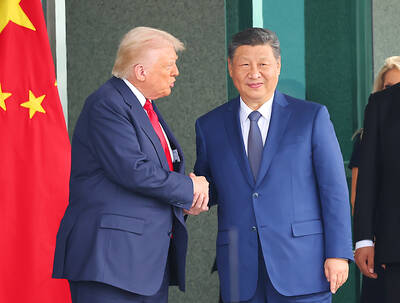The National Science Council said it will help firms in the Tainan Science-based Industrial Park (台南科學園區) deal with vibrations that will come from the planned high speed railway, National Science Council Chairman Wei Che-ho (魏哲和) said yesterday.
Wei said at the Legislative Yuan that the council would help firms to enhance their ability to resist the vibrations.
"The priority now is to communicate with high-tech firms and help them understand the government's plan for the railroad," Wei said yesterday.
Wei repeated more than once on the vibration issue that problems would eventually be solved through technology.
Parts of the industrial park are only 200m from the planned rail line. Many firms believe that vibrations created by the railroad (about 68 decibels) is far beyond acceptable limits.
Since February, worries over the vibrations have resulted in a chain reaction of high-tech firms aborting projects at the park.
Most of the firms that have decided to look elsewhere are DRAM chipmakers, including Winbond Electronics Corp (華邦電子), Silicon Integrated Systems Co (矽統科技) and Chi Mei Electronics Corp (奇美電子).
Taiwan Semiconductor Manu-facturing Co (
Meanwhile, the Ministry of Transportation and Communications has initiated a project to figure out how to reduce the railroad's vibration down to about 50 decibels.
In an effort to offer a solution to the problem, officials at the Council's National Center for Research on Earthquake Engineering will soon carry out a field investigation in Japan to study the structure of the Shinkansen (
Wei said that the earthquake project would do its best to help companies to lower vibrations down to about 48 decibels, which most high-tech firms say they can accept.
Tainan County residents established a self-help group to call for a solution to the vibration problem.
Hou Shui-sheng (

RUN IT BACK: A succesful first project working with hyperscalers to design chips encouraged MediaTek to start a second project, aiming to hit stride in 2028 MediaTek Inc (聯發科), the world’s biggest smartphone chip supplier, yesterday said it is engaging a second hyperscaler to help design artificial intelligence (AI) accelerators used in data centers following a similar project expected to generate revenue streams soon. The first AI accelerator project is to bring in US$1 billion revenue next year and several billion US dollars more in 2027, MediaTek chief executive officer Rick Tsai (蔡力行) told a virtual investor conference yesterday. The second AI accelerator project is expected to contribute to revenue beginning in 2028, Tsai said. MediaTek yesterday raised its revenue forecast for the global AI accelerator used

TEMPORARY TRUCE: China has made concessions to ease rare earth trade controls, among others, while Washington holds fire on a 100% tariff on all Chinese goods China is effectively suspending implementation of additional export controls on rare earth metals and terminating investigations targeting US companies in the semiconductor supply chain, the White House announced. The White House on Saturday issued a fact sheet outlining some details of the trade pact agreed to earlier in the week by US President Donald Trump and Chinese President Xi Jinping (習近平) that aimed to ease tensions between the world’s two largest economies. Under the deal, China is to issue general licenses valid for exports of rare earths, gallium, germanium, antimony and graphite “for the benefit of US end users and their suppliers

Dutch chipmaker Nexperia BV’s China unit yesterday said that it had established sufficient inventories of finished goods and works-in-progress, and that its supply chain remained secure and stable after its parent halted wafer supplies. The Dutch company suspended supplies of wafers to its Chinese assembly plant a week ago, calling it “a direct consequence of the local management’s recent failure to comply with the agreed contractual payment terms,” Reuters reported on Friday last week. Its China unit called Nexperia’s suspension “unilateral” and “extremely irresponsible,” adding that the Dutch parent’s claim about contractual payment was “misleading and highly deceptive,” according to a statement

Artificial intelligence (AI) giant Nvidia Corp’s most advanced chips would be reserved for US companies and kept out of China and other countries, US President Donald Trump said. During an interview that aired on Sunday on CBS’ 60 Minutes program and in comments to reporters aboard Air Force One, Trump said only US customers should have access to the top-end Blackwell chips offered by Nvidia, the world’s most valuable company by market capitalization. “The most advanced, we will not let anybody have them other than the United States,” he told CBS, echoing remarks made earlier to reporters as he returned to Washington